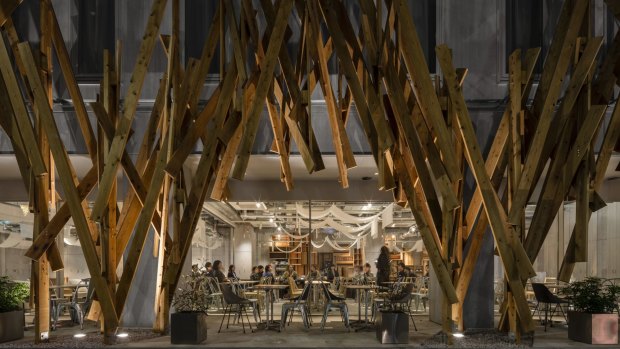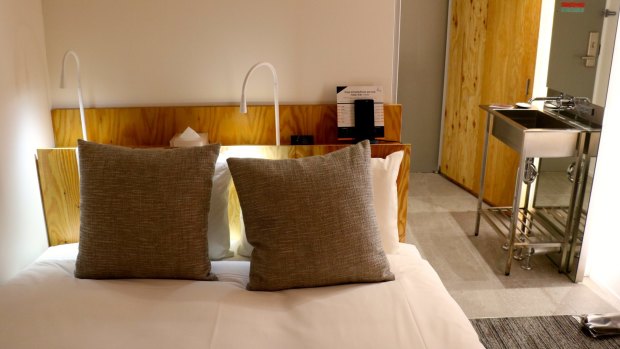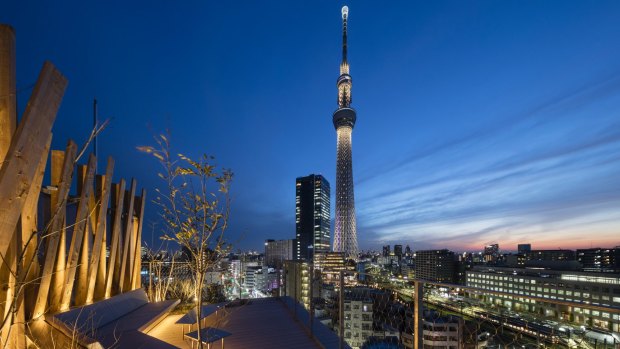This was published 1 year ago
ONE@Tokyo review: This striking hotel does Japanese ultra-minimalism brilliantly

ONE@Tokyo's pick-up-sticks facade, a jumble of lumber bolted together to evoke a forest.
It's a chilly afternoon when I arrive at ONE@Tokyo in north-eastern Tokyo and I'm in a hurry to get inside. Then I see the hotel's pick-up-sticks facade, a jumble of lumber bolted together to evoke a forest, which stops me in my tracks. It's a signature move by Kengo Kuma, one of Japan's best-known architects, who's famous for his use of wood - even in mega-structures like the 60,000-seat National Stadium, the centrepiece of Tokyo's 2020 Summer Olympics.
The woodsy theme continues inside where the reception desk is a long slab of timber that extends into the hotel's airy street-level restaurant, an industrial-looking space softened by communal wooden tables and a ceiling draped with lengths of dreamy white fabric.
With 142 rooms, ONE@Tokyo, which opened in 2017, might sound like a big hotel, but most of them are ultra-minimalist studios. (There are also 21 larger deluxe rooms, two suites and a universal wheelchair-accessible room.)

Most of the hotel's rooms are ultra-minimalist studios.
My studio on the second floor is just 14 square metres, making it only slightly bigger than the double bed inside it, though it's a Japanese double, which is slightly larger than a Western double. Still, the room is so artfully designed it doesn't feel poky.
The first things I notice are the high ceiling and the plywood panels creeping up one wall and over the window to create warmth and familiarity, "a quality absent in many contemporary hotels", according to architect Kuma. Everywhere I look, clever features maximise space: a wooden stool doubles as a bedside table, there are corner cupboards and a triangular desk, wall-mounted hooks and coat-hangers take the place of a space-sucking wardrobe, and a washbasin in the hall makes the bathroom more roomy.
It's also one of the most guest-friendly rooms I've stayed in. There are power points in all the right places, including three universals and two USB ports. Light switches are labelled so there's no need to play "Which switch is which?" A wide shelf built into the bedhead keeps books, phones and cups of tea within reach. And the "Do Not Disturb" tag is magnetic, sticking firmly to the door - no more surprise housekeeping visits.

The hotel has a rooftop garden, the perfect spot for a Sapporo sundowner amid a "sky forest" of more stick-like trees – while looking up at Tokyo Skytree.
Although the ground-floor restaurant hasn't reopened post-COVID-19 lockdowns, the hotel has a rooftop garden, the perfect spot for a Sapporo sundowner amid a "sky forest" of more stick-like trees – while looking up at Tokyo Skytree. The world's tallest free-standing broadcast tower is a couple of minutes walk away and its viewing deck 450 metres above street level is the ideal place to get your bearings in this sprawling city; on a clear day you can even see a distant Mount Fuji.
When it opened in 2011, Skytree dragged the hotel's once-traditional neighbourhood of Oshiage into the 21st century, but you can still dip a toe into Edo-era Japan here – by renting a kimono, doing a rickshaw tour, taking a calligraphy class. Or you can visit the nearby Hokusai Museum; the artist best known for his Great Wave off Kanagawa woodblock print spent most of his life in this corner of Tokyo.
ONE@Tokyo is that rare thing in travel: an innovative design hotel that keeps travellers' needs front and centre while subtly transforming a simple stay in one of the world's great cities into an opportunity to inhabit, for a night or two at least, the work of one of Japan's rock-star architects.
THE DETAILS
FLY
Qantas flies direct from Sydney and Brisbane Tokyo (Haneda) with plans to resume direct Melbourne-Tokyo (Haneda) flights in March. ONE@Tokyo is 36 minutes from Haneda (54 minutes from Narita) by train. See qantas.com
All travellers to Japan, except children under 18, must be triple vaccinated against COVID-19 or show a negative PCR test within 72 hours of departure from Australia.
STAY
ONE@Tokyo's rooms start at 5800 yen ($62) a night per person for a Studio, opening promotion valid until August 31, 2023. See onetokyo.com/en/
MORE
Louise Southerden stayed at her own expense with flights by Tourism Shizuoka Japan.
Sign up for the Traveller Deals newsletter
Get exclusive travel deals delivered straight to your inbox. Sign up now.